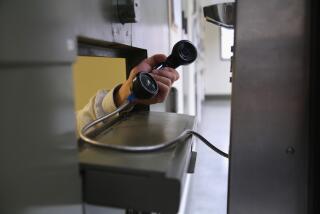S.D. Firms Market Programs to Deliver Services in Spanish
Brewers and cigarette manufacturers long ago learned that it’s good business to advertise their products in Spanish-language commercials and advertisements.
But a handful of local companies are taking Spanish-language advertising a step further by establishing programs that promise to deliver often-complicated services to customers whose only--or preferred--language is Spanish.
San Diego Gas & Electric last month began advertising “Linea Directa,” which allows customers to talk directly to Spanish-speaking service representatives. The “Direct Line” was installed because the utility is now handling more than 125,000 calls each year from Spanish-speaking customers.
In January, Mercy Hospital unveiled Hispanocare, a marketing program that promises health care delivered by Spanish-speaking doctors and nurses.
Hispanocare, which is licensed from a Chicago-based hospital, has attracted about 8,000 members in San Diego since its formation about a year ago. Hispanocare offers its members primary and specialty care from nearly 130 bilingual doctors and health care experts who are on staff at Mercy.
Although retailers are experienced at using mass marketing to pitch food and beverages to consumers in their native language, relatively few companies have successfully created and actively marketed programs that will deliver services in a language other than English.
Consequently, before working with a client to create a Spanish-language program, “we always ask if they have people who are sensitive, who understand the language and the culture,” said Elida Chavez, owner of Elida Chavez & Associates, a San Diego-based advertising and marketing firm that helped to develop SDG&E;’s Linea Directa program.
“If they don’t have that (personnel) in place, we highly recommend that they don’t start a marketing or advertising campaign,” Chavez said. “Not only is the client or customer not going to get serviced well, but the company doesn’t look good, either.”
Programs that are designed to deliver services in Spanish are timely, given San Diego’s fast-growing population of Spanish-speaking consumers, said Patricia Cohen, president of Cohen Advertising Group, which helped craft the Hispanocare advertising program.
And, Cohen said, it makes good business sense for companies that want to expand their share of the Latino market. But Cohen acknowledged that programs can backfire if sponsoring organizations lack the personnel needed to make the language programs work.
Even well-intentioned programs can generate controversy.
That was the case with Hispanocare, the successful Spanish-language program that drew unwanted publicity earlier this year after Irma Munoz, a bilingual patient, complained publicly about a lack of Spanish-speaking personnel in the hospital’s emergency room.
Munoz, a public affairs officer for the Centre City Development Corp., praised Mercy for the quality of medical care she received during an emergency room visit. But Munoz was upset because emergency room personnel were ill-equipped to communicate with the large number of Spanish-speaking patients who were seeking medical care.
Mercy officials subsequently acknowledged that a bilingual employee was not on duty on the day in question because of a “scheduling error.”
But Mercy spokesman Michael Scahill noted that the advertised guarantee of Spanish-language service was specifically aimed at members of the Hispanocare program, not necessarily the emergency room.
However, Scahill also said that emergency room personnel “have been offered training and counseling” to help deal with high-pressure situations that arise.
“Nerves do get frayed (in the fast-paced emergency room) but the bottom line is that we have to be patient-oriented,” Scahill said. “People are coming in in pain. They’re scared, and it’s all the worse if they don’t speak the language.”
Munoz remains at odds with Hispanocare over advertisements on Spanish-language television and radio stations that she described as “misleading” because Spanish-speaking residents are led to believe that Spanish-language care is being provided throughout Mercy’s system.
“The bottom line is that . . . what you advertise, you have to deliver,” Munoz said. “If your advertisements ask people to patronize your business because you’re bilingual, you had better be prepared to deliver.”
SDG&E; officials, aware that Spanish-language calls were on the rise, in March established a special Spanish-language telephone number. Previously, calls were taken by an English-speaking service representative who transferred the call to a bilingual associate.
The Direct Line “is more efficient for our company . . . because we were using two representatives to handle one call from a customer,” said Susanna Conners, manager of SDG&E;’s Customer Service Telephone Center.
SDG&E; has assigned 11 full-time customer service representatives to the Linea Directa program. The representatives offer the same services that are handled by English-speaking employees. The utility is designing a compensation package to reward employees for their bilingual skills, Conners said.
Similarly, the UC San Diego Medical Center has at least two interpreters trained as “patient assistants,” on duty in its emergency room, according to spokeswoman Laura Humphrey. The interpreters, who do not provide medical care, are trained to assist care givers who are not bilingual.
Special training for employees and compensation that recognize bilingual skills are a positive step, according to personnel experts who cautioned that programs can backfire if bilingual staff members are constantly pressed to handle interpreting as well as their normal duties.
Advocates of Spanish-language programs said the programs are likely to grow in popularity, even at a time when societal debate over an ethnic group’s right to continue speaking its own language is intensifying.
“It’s very critical that people learn English because it’s the business language, the only language that leads to meaningful employment and education,” said Roger Cazares, executive director of the nonprofit Metropolitan Area Advisory Committee.
“But Spanish-language programs are important when it comes to crisis situations . . . like gas leaks, toxic fumes . . . or hospitals that have a large segment of their population that has a different culture or language,” Cazares said. “It’s critical that the social worker, doctor or nurse speak the language of the client or customer.”
Spanish-language advertising that urges Latinos to patronize a company can be expensive, Cohen said. “That stops a lot of companies,” Cohen said. “It means changing your whole attitude . . . changing a company’s mind-set, and spending money to make the change.”
But Munoz argues that “it’s a good business decision to be bilingual in this state, because you’re more marketable to a greater number of people. But the irony of this situation is that . . . across the border, where the predominant language is Spanish, they’ve wised up an realized they need to also speak English. California is missing it.”
More to Read
Inside the business of entertainment
The Wide Shot brings you news, analysis and insights on everything from streaming wars to production — and what it all means for the future.
You may occasionally receive promotional content from the Los Angeles Times.










